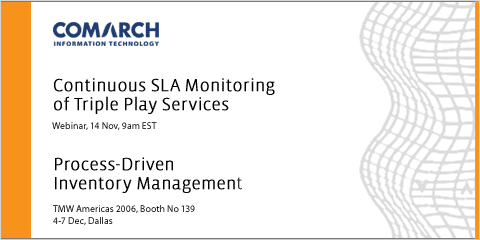|
|

article page | 1 | 2 |
3. Separately optimized management of both connectivity and applications. The design and activation of the connectivity portion of a service presents distinctly different challenges from the configuration of the application. Connectivity configuration involves interfacing into a very complex multi-vendor environment to lay in a service construct end-to-end. Application configuration may seem simpler, but service and feature conflicts need to be managed and transaction volumes are much higher volume, especially in a self-service context. Hence, application configuration must be optimized for volume. These separate capabilities call for a system of modular components that are designed to handle the distinct performance requirements, yet that can be orchestrated across both the connectivity and application layers, as noted above.
4. Discovery and abstraction of network resources and capabilities. Most importantly for any service creation environment is the understanding of the actual network and resources available for service delivery and consumption by subscribers. This is most often accomplished by using a discovery engine as a mechanism to build a picture of the network “as is.” This approach enables service design and assign to be based on an accurate view of network resources, minimizing provisioning fallout and boosting automation and flow-through. Beyond the fulfillment process, the abstraction of network resources in this method permits other OSS/BSS processes to have a more precise view of actual network
|
|

This need for a common platform is driven in part by the increasingly converged nature of the services offered by carriers, but also by the requirements imposed by the layering of applications on the connectivity. In essence, a platform enables the generalization and abstraction of a set of network capabilities, some of which may exist only at certain layers, such as QoS mechanisms. But it does this in a way that these capabilities can become usable to support a service template or construct that is not tied to any one layer.
An OSS in this architecture actually begins to resemble an OS platform. Just like an OS has southbound interfaces to printers, network adapters, output devices, etc., the telecom OS platform has southbound interfaces that support the multivendor network environment, as well as the application servers.
A PC OS exposes the capabilities of the PC’s hardware to upper level applications in a simplified way, allowing those applications to make use of the system capabilities without having to interface directly into the devices. This simplifies and accelerates the execution of processes and also simplifies the creation of PC applications that take advantage of the system capabilities.
Similarly, the evolved OSS platform exposes the network and application server’s capabilities to upper layer operational systems and processes, accelerating the execution of functions such as fulfillment and assurance.
|
|
|
|

resources. For example, a view of the network “as is” can boost service assurance efforts, enabling operations personnel to understand the actual resources in the network affected by a service outage and, ultimately, gain a better view into how customers are affected.
The end result of this transformation is an OSS that looks less like a traditional operations support system and more like a PC’s operating system.
Losing an “S” … the New Telecom OS
Like a PC’s OS, the new OSS generally must take the form of an integrated platform, as opposed to the traditional OSS, whose functional processes were typically siloed based on layer or segment of the network.
|
|

As a result, it becomes simpler and faster to build new processes and service definitions that reside on the platform. Where this becomes most valuable is in the effort to automate processes that involve multiple layers of the network or multiple applications, such as in a Triple Play service delivering multiple applications over a common connection.
In the end, a platform approach provides a foundation for orchestration among the increasingly complex components of a next-generation service. Achieving that seamless orchestration is the key to capturing and keeping subscribers and reducing churn. In fact, like a restaurant with good communication between the kitchen and the wait staff, this approach can go a long way toward ensuring a positive customer experience.
|
|
|
|




